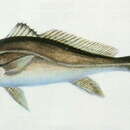en
names in breadcrumbs


Bahaba is a genus of marine ray-finned fishes belonging to the family Sciaenidae, the drums and croakers. These fishes are found in the Indo-West Pacific region.
Bahaba was first proposed as a monotypic subgenus of the genus Otolithes in 1935 by the American ichthyologist Albert William Herre with its type species being Otolithes (Bahaba) lini. In 1977 Ethelwynn Trewavas treated it as a valid genus in her paper called The sciaenid fishes (croakers or drums) of the Indo-West-Pacific published in the Transactions of the Zoological Society of London and most authorities now treat the genus as valid.[1] Trewavas also stated that Herre's Otolithes lini was a junior synonym of Nibea taipingensis, which Herre had described in 1932.[2] Bahaba belongs to the family Sciaenidae in the order Acanthuriformes.[3] Some authorities place Bahaba in the subfamily Pseudosciaeninae[4] but subfamilies are not recognised within Sciaenidae by Fishes of the World.[3]
Bahaba is the word used in the Samal language of the Sulu region of Mindanao in the Philippines for drums and croakers.[5]
The currently recognized species in this genus are:[6]
Bahaba is distinguished from other sciaenids by the form of their swim bladder which has unbranched horn-like or tube-like appendages which start at the anterior end of the swim bladder and are directed to the rear.[7] The Chinese bahaba is the largest species, having a maximum published total length of 200 cm (79 in) while that of the chaptis bahaba is 50 cm (20 in) and the spine bahaba is 40 cm (16 in).[6]
Bahaba is found in the Indo-West Pacific with one species in the coastal Bay of Bengal,[8] one endemic to the coastal waters of southern China[9] and the third in Southeast Asia.[10]
Bahaba is a genus of marine ray-finned fishes belonging to the family Sciaenidae, the drums and croakers. These fishes are found in the Indo-West Pacific region.